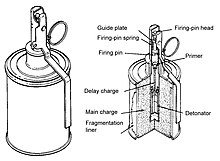RG-42
| RG-42 grenade | |
|---|---|
 |
|
| Type | Hand grenade |
| Place of origin |
|
| Service history | |
| Used by |
Soviet Union People's Republic of China |
| Wars |
World War II, Korean War, Vietnam War |
| Production history | |
| Designer | S.G. Korshunov |
| Designed | c.1942 |
| Produced | 1942-1954? |
| Specifications | |
| Weight | 500 grams (18 oz) |
| Height | 121 millimetres (4.8 in) |
| Diameter | 54 millimetres (2.1 in) |
|
|
|
| Filling | TNT |
| Filling weight | 200 grams (7.1 oz) |
|
Detonation
mechanism |
Time-fuse, 3-4 seconds |
The Soviet RG-42 (Ручная Граната образца 42 года > Ruchnaya Granata obraztsa 42 goda, "Hand Grenade pattern of [19]42 year") was a fragmentation grenade designed by S.G. Korshunov. It was originally introduced during World War II from 1942 onwards as an emergency measure to replace the complex RGD-33 grenade. It continued in use with the USSR and its Warsaw Pact allies in the post-war period until replaced in 1954 by the RGD-5 grenade. Stockpiles were held for emergency or reserve issue, military aid, or foreign sales. They were eventually destroyed in the 1980s due to the TNT filling degrading and becoming unsafe.
Unlike the RGD-33, the RG-42's components were simple to produce and assemble. Only the fuze required specialized manufacture and the parts could be easily assembled by hand by cottage labor. Partizans often made copies of the simple design when out of contact.
It contained about 200 grams of explosive charge (TNT) in a cylindrical stamped-metal can. It used the 3.2 to 4 second UZRGM fuse, also used in the RGD-5, RG-41, and F1 grenades. The grenade could be thrown about 35–40 meters and has an effective blast radius of around 10 meters. The total weight of the grenade with the fuse was about 500 grams.
...
Wikipedia
